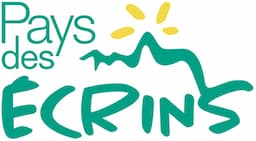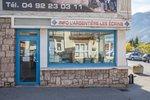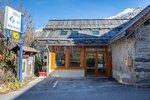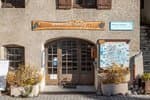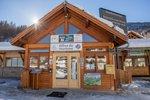Puy-Saint-Vincent resort
This high-altitude site, with its alpine configurations and exceptional snow conditions, offers you access to numerous viewpoints and unique panoramas of Mont Pelvoux, the Glacier Blanc and the Durance valley. You'll move between sunny plains and frozen larch forests.
Description
Prices for activities other than cross-country skiing in the Nordic area are available here and passes are on sale at the lift ticket offices and at the Puy Saint Vincent Nordic Chalet.
The starting point of all itineraries is at the nordic chalet. Coat racks and hot tea are available at the chalet.
Access by road:
From the N94 Gap-Briançon, turn off at l'Argentière-la-Bessée, direction Puy-Saint-Vincent.
Parking and access to the Nordic chalet:
Access from station 1400 :
Once parked at station 1400, take the Prés chairlift. At the top of the chairlift, carefully cross the downhill ski slope to reach the Nordic ski area entrance directly opposite. Once on the cross-country track, follow the signs to the Nordic chalet.
Access from station 1600 :
Once you've parked at station 1600, carefully cross the downhill ski slope to reach the shared "Accès 1600" trail (1 km one way).
Access from station 1800 :
Once parked at station 1800, access to the Nordic chalet is via the shared "Accès Pré Loubet" piste (1.5 km one way).
Information on access and transport is available in the practical info section of our website.
Access to the Nordic site is forbidden after 4:30pm.
Allow grooming in complete safety and peace of mind for drivers. When you walk or snowshoe on groomed sections, you leave tracks that will harden overnight and remain the next morning.
Think of your own safety!
Don't forget that a grooming machine in use presents risks (limited visibility inside and powerful rotating parts). Some machines are equipped with a winch with a tensioned cable that runs for almost 1,000m on the alpine ski slopes being prepared. This cable, at man's height, cannot be seen at night, and can be life-threatening.
- Towns crossed : L'Argentière-la-Bessée, Les Vigneaux, and Puy-Saint-Vincent
Les 6 parcours à découvrir
Sensitive areas
Black grouse - winter
- Impacted practices:
- , Land
- Sensitivity periods:
- JanFebMarAprDec
- Contact:
- Parc National des Ecrins
Thierry Maillet : thierry.maillet@ecrins-parcnational.fr
Membre de l'Observatoire des Galliformes de montagne
Virginie Dos Santos : ogm.vds@gmail.com
Blandine Amblard : ogm.amblard@gmail.com
Short-toed snake eagle
- Impacted practices:
- Aerial,
- Sensitivity periods:
- MarAprMayJunJulAugSep
- Contact:
- Parc National des Écrins
Julien Charron
julien.charron@ecrins-parcnational.fr
Golden eagle
- Impacted practices:
- Aerial, , Vertical
- Sensitivity periods:
- JanFebMarAprMayJunJulAug
- Contact:
- Parc National des Écrins
Julien Charron
julien.charron@ecrins-parcnational.fr
Golden eagle
- Impacted practices:
- Aerial, , Vertical
- Sensitivity periods:
- JanFebMarAprMayJunJulAug
- Contact:
- Parc National des Écrins
Julien Charron
julien.charron@ecrins-parcnational.fr
Peregrine falcon
- Impacted practices:
- Aerial, Vertical
- Sensitivity periods:
- FebMarAprMayJun
- Contact:
- Parc National des Écrins
Julien Charron
julien.charron@ecrins-parcnational.fr
Recommandations
A few rules:
→ You use these routes at your own risk. Find out about the weather conditions and avalanche risks published by Météo France. Also, don't hesitate to ask at tourist information offices or the Nordic chalet before you set off.
→ For avalanche-prone trails, we strongly advise you to take your avalanche transceiver, shovel and probe with you.
→ Night-time activities on Nordic areas are prohibited. It must be supervised by a professional and must be authorized by the ski slopes service.
→ Several itineraries are shared with cross-country skiers and ski tourers: give them priority, always walk along the edge of the piste and be vigilant when crossing these shared paths.
→ Many routes cross downhill ski slopes; be vigilant and give skiers the right of way.
→ Don't walk in the cross-country ski tracks, straddle them.
→ Respect the signposting: dangers, prohibitions, trail directions, among other things.
→ Don't overestimate your abilities!
→ Dogs are tolerated, on a leash, off the cross-country ski trails (dogs prohibited on the Lauzet itinerary of the Puy-Saint-Vincent ski area, reserved for approved sled dog teams).
→ Take your garbage with you!
Please note: This information is given for guidance only. It is your responsibility to check the weather forecast before setting off and not to overestimate your possibilities. The Tourist Office and the PNE cannot be held responsible in the event of an accident. In case of doubt, contact professionals: instructors or equipment hire companies.
Mountain Rescue : dial 112
Information desks
23 Avenue de la République, 05120 L'Argentière-La Bessée
Les Alberts, 05290 Puy Saint Vincent 1400 m
Place de l'Eglise, 05340 Vallouise
Station de Ski de Pelvoux, 05340 Vallouise-Pelvoux
Les Alberts, 05290 Puy-Saint-Vincent
34 points of interest
 Know-how
Know-howThe chenevières, hemp fields
There is a French saying «Avril donne le fil», meaning that April is string time. Sown in spring after the last frosts, the tall stems of hemp grow in tiny plots of ground, called chenabiers or chenevières. The hemp is cut at the end of August and the strands are immediately immersed in large holes filled with water - called the naïs - on the edge of wet meadows. They are left to steep for more than a month, in order to release all the gum that binds the plant fibres together.
 Know-how
Know-howHemp production
At one time, almost every winter evening would be taken up by stripping the fibre from the hemp straw. The strands had to be broken one by one, to remove the long, flexible filaments. Once washed and combed, these «balls» of hemp were taken to the rope and yarn spinners to be turned into rope, blankets and cloth for garments. When a family ordered cloth from the weaver, the entire family would go to the loom to attach the threads onto the warper.
 Architecture
ArchitectureThe commons
As «crosswise» as it might be, from end to end the main street of Puy-Saint-Vincent has every building the community needs. The mill is still here, complete with its intake and outlet mill races. The communal oven is lit on 14 July every year. It has just been restored and shares the little paved square with a lovely water fountain, made from wood and ringed with iron.
 History
HistoryThe church of Sainte-Marthe
The church of Sainte-Marthe was built in the nineteenth century, in 1817 to be precise, as indicated at the top of the pediment. Only the main facade has a painted decoration. On two superimposed levels and on the gables, pilasters or false pillars frame either bay windows illuminating the nave, or panels painted with a false marble decoration. A few steles remind us of the present of the former cemetery. Included on the Supplementary Inventory of Historical Monuments, this church also contains a commemorative plaque honouring those who fell in the First World War.
 Architecture
ArchitectureSolid architecture
Originally, the environment of the high valleys of the Pays des Écrins offered little space, in which men and animals cohabited. Unlike in Vallouise, where the architecture is a harmonious blend of arcades and decorative elements, the houses in Le Puy retain the rusticity of completely stone-built single block construction with half-hipped roofsprotruding over a drying balcony. This roof extension protects the main facade from bad weather, snow in particular. People can move about under shelter and the firewood store stays dry all winter. This barrel vaulted porch, which shelters the entrance to the main building and the stable, mirrors the Champsaur-Valguademar, «toune» (ground level arcade).
 Architecture
ArchitectureProtective shelter
Separate from the main building and at a distance from the barn, some property owners also have a small building providing safety from the much feared home fires. Here, in the coolness of this outside cellar, they stored ham, cheeses, flour, salt and other foodstuffs, but also whatever the family owned by way of valuables.
 Fauna
FaunaThe Eurasian pygmy owl
The call of this small, nocturnal bird of prey can be heard in the spring, and also in the autumn when it can utter some peculiar sounds. Active during daytime hours and at dusk, the pygmy owl is a predator of passerine birds and small forest rodents. But when they spot it, passerines will come together in large numbers to mob it, so as to prevent any attempted surprise attack. It is restricted to mountain forests where it seeks out trees with woodpecker cavities in which it builds its nest.
 Fauna
FaunaCliff-dwelling birds
The cliff is home to a variety of birdlife. The raven, not to be confused with the crow, frequently nests here. He makes an uncomfortable housemate with the peregrine falcon, a bird in sharp decline and still a vulnerable species. It, too, favours this cliff, which offers plenty of potential nesting holes. The wallcreeper, also known as the butterfly bird, also finds this a good nesting spot. Some climbing routes are closed during this bird's breeding season.
 Pass
PassThe Col de la Pousterle
A pousterle (in the local high-alpine Occitan language) is a small gate, a postern. It comes from the Latin posterula which means back door. This place name is sometimes given to a pass, which could be described as a gateway between two valleys! The glaciers carved out this gateway through which an arm stretched between the glacier occupying the Fournel valley and the glacier flowing down the Vallouise valley.
 Flora
FloraThe larch
The symbol of the Southern Alps, this softwood tree loses its leaves in winter, and is swathed with gold and lights up the mountains in autumn. The larch forests are maintained by the grazing of flocks. Without them, other trees like the fir or other pine trees could grow, creating a different kind of forest. A pioneer species, the larch establishes freely in light conditions. Its solid rot-proof wood has always been used in the construction of houses.
 Fauna
FaunaForest-dwelling bats
Bats don't just live in caves! In summer, some forest-dwelling species shelter in old hollow trees or woodpecker holes during the day. Sometimes, the females also form little colonies here, where their young will be born (one bat pup per female). In this forest, which is still young with very few old trees, artificial roosts have been installed to help the bats and to facilitate their study. History
HistoryThe Sentier du Facteur - the postman's path
In former times, the postman would take this path every day: He would set out from Vallouise, deliver letters in Puy-Saint-Vincent and drop back down to Vallouise, stopping at the hamlets of Parcher on the way. In the winter, when the snow was too deep, the Traversouires (the inhabitants of Puy-Saint-Vincent) donned their snowshoes and wielded their shovels to clear the postman's path down to Vallouise.
 Fauna
FaunaThe ptarmigan and the mountain hare
The rock ptarmigan, a member of the grouse family, and the mountain hare are both perfectly adapted to high-altitude life. Among other adaptations, they turn white in winter in order to escape the attention of predators, and they are grey-brown in summer. In addition, their feet are covered with feathers or fur, and act as snowshoes when moving over snow. They are particularly threatened by the increasingly early arrival of the flocks in the alpine pastures, the boom in winter tourism and climate change.
 Flora
FloraThe aspen
A sizeable aspen grows on the roadside, on the edge of a small wood of fellow-aspens. This tree has a smooth, greenish trunk and rounded, crenelated leaves which take on magnificent colours in autumn. The stem, or petiole, of aspen leaves is flat and twisted, so it can be caught by the slightest breeze making the foliage «quake» hence its common name, the quaking aspen. It grows in places where the soil is quite damp.
 Flora
FloraThe ash tree
This is one of the most common trees, provided the ground is relatively cool. It is characterised by its pinnate leaves, that is to say, made up of several segments, and in winter is can be recognised by its large black leaf buds. The ash was extremely important in times past: its foliage was used to feed cattle and its hard, flexible wood was used to make a variety of objects such as tool handles.
 Fauna
FaunaThe clouded Apollo
This butterfly with hyaline (glass-like) translucent white wings, marked with two black spots, flutters around the clearing or the edges of the forest, where the host plants of its caterpillars grow: the corydalis. Although abundant locally, it is nevertheless a species in sharp decline and is protected.
 History
HistoryThe church of Sainte-Marie-Madeleine-des-Prés and its two sun dials
The charming little church of Sainte-Marie-Madeleine-des-Prés, which dates from the sixteenth century, stands in the hamlet of Les Prés. It is surrounded by a wall and a cemetery. On the walls of the church, two sun dials can be seen, both engraved and painted on plaster in 1718. The first is above the door, telling the time in the afternoon, bearing the saying « for a moment of delights, an eternity of torments » which alludes to the life of Saint Mary Magdalene, the well-known sinner who is venerated as a model of penitence. The second, telling the time in the morning, bears the Latin phrase Ars longa, vita brevis which translates as« learning is long, life is short ».
 Flora
FloraThe martagon lily
In cooler spots, the path is edged by large plants such as the wood cranesbill, which has purple flowers, and the martagon lily. This superb plant has large hanging flowers with curved-back petals, which are pink speckled with purple and exposed orangey stamens. Its leaves are elongated and whorled. It grows in meadows and cool woods. Although common here, it is rare in many French regions. In fact, picking it is prohibited or regulated. Panorama
PanoramaTournoux
The Tournoux plateau is a small paradise with its cool meadows, its occasional renovated chalets made from stone and larch wood and its view over the Tête d'Aval, an imposing limestone peak forming part of the Montbrison massif. Whether on a mountain bike, on foot or on cross-country skis in the winter, this spot is always an invitation to stop for a break!
 Fauna
FaunaThe common raven
A hollow "caw" makes you lift up your head (careful not to trip!). A pair of common ravens is nesting near here (they pair for life), on a cliff face. Although bigger than its cousins the carrion crow and the rook, it can be identified by its rather lozenge-shaped tail. It almost became extinct due to persecution Yet it's an omnivore and, more particularly, a scavenger which plays an important role by cleaning up disease-prone carcasses. Panorama
PanoramaThe Fournel valley
This is the southern side of the Col de la Pousterle and its view over the very long Fournel valley, known for its mines, ice waterfalls, blue thistles, its canyon and other treasures. Lower down is L'Argentière-la-Bessée. At the highest point, right in the distance, is the Champsaur! History
HistoryLes Prés, hamlet of Puy-Saint-Vincent
Le Prés is one of the main hamlets of Puy-Saint-Vincent. Like Le Puy and Les Alberts, it stands on a flat plateau which is a glacial escarpment left by the now-retreated Gyronde glacier. Like Prey d'Aval, Prey du Milieu and Prey d'Amant, its name is a reminder that prior to the development of the ski resort, the land here used to be shared by meadows and crops.
 Fauna
FaunaThe peregrine falcon
Cries echo around the cliffs. A pair of peregrine falcons nests there regularly. A real "fighter plane" with tapered wings, it is a formidable predator of pigeons and other birds. It came very close to extinction because of pesticides, but it remains endangered because the eggs are still stolen for the falconry trade, even though it is a protected species. It is also sensitive to disturbance. Climbers are urged not to climb in this area in the spring.
 Flora
FloraThe yellow cephalaria
Rather like a tall scabious (up to 2 metres) but with pale yellow flower heads, this is not a common plant. Yet, at an intersection of two tracks, it has established on a small patch of ground. Who knows why! It is a mountain plant which only lives in the west of the Alpine Arc..
 Vernacular heritage
Vernacular heritageThe ski resort of Puy Saint Vincent
The original resort was created in Les Prés in 1968. Then,1974 saw the start of construction Grande Barre 1600, which in every respect chimes with the tourist architecture of the 1970s. The new 1800 resort, with its wood and stone chalets, dates from 2005: more modest sizes, more sympathetic materials similar to local species. It's the third generation of the resort. Vernacular heritage
Vernacular heritageThe irrigation canals
The route follows a canal side for a short distance. Numerous canals brought water from the Torrent de la Combe mountain stream to the fields which take up a large area around the villages of Puy-Saint-Vincent. In fact, the slopes just above these fields did not provide sufficient water, making it necessary to create this large network of irrigation canals. Vernacular heritage
Vernacular heritageLe Laus
A number of old alpine pasture chalets or hamlets, often renovated, are dotted across the Puy-Saint-Vincent resort. These are the Chalets du Laus. Le Laus is a place name designating a lake. In fact, just after the chalets, although not a lake, there is a flat, marshy area which is no doubt a small filled-in lake. So no point in bringing your pedalo! Panorama
PanoramaThe Les Têtes belvedere
This belvedere is worth the diversion, not only for its unrestricted panorama over the Fournel and Durance valleys but also for the place itself, with its sparse mature larches and the bare limestone scored with small fissures. These were created by the erosion of the rock by cold snowmelt waters or rain.
 Architecture
ArchitectureThe architecture of La Voile in Puy-Saint-Vincent 1600
The construction of this large building complex, the highest part of which is known as « La Voile »(the sail), was started in 1973 by a team of investors responsible for developing the 1600 ski resort. Designed by the Grenoble-based architect, Michel Ludmer of the Les 3A firm of architects, this tiered construction hugs the slopes with its silhouette, its soaring design structured around a mast, like the sail of a yacht sailing in a sea of snow. La Voile was inspired by iconic buildings in other tourist resorts, like the « Paquebot des Neiges » (the snow liner) in La Plagne and the « La Grande Pyramide » (great pyramid) in La Grande-Motte. Although still misunderstood, this architecture which presents numerous advantages (like restricting the use of space) might well merit a « Twentieth Century Heritage » label. History
HistoryThe restoration of the canals
Water is essential to farming in our territory because of the relatively dry Mediterranean climate with hot summers. To compensate for this, our ancestors created artificial water courses, the canals. These performed a dual role because they served not only to irrigate the hay meadows, kitchen gardens and grain fields, but also to prevent torrential flooding by acting as drains. Today, the canals are still used and managed by associations which work to keep them operational and to maintain them, several times a year. History
HistoryThe house with arcades
In the municipality of Puy-Saint-Vincent, there are a number of houses typical of the rural architecture of Vallouise, in particular houses with arcades, in the hamlets of Les Alberts and Les Prés. This type of construction can be recognised by the presence of large arches made from stone from the Montbrison massif and supporting walking galleries. Introduced in the eighteenth century by Piedmontese master masons who settled in the valley, this style with arcaded galleries has become characteristic of the architecture of the Vallouise valley. Elegant and monumental, they replaced modest wooden balconies. They facilitated mobility from one level of the house to the other (the houses did not have interior stairs), and at the same time signalled the wealth of the owner. History
HistoryThe history of the resort of Puy-Saint-Vincent
Puy-Saint-Vincent is the benchmark resort in the Vallouise. Located on the north-facing side of the valley, it is constructed on three levels, each corresponding to a different period of construction: 1400, developed in the late 1970s, 1600, developed from 1973 onwards and 1800, developed from 2005 onwards. Each level is served by a chairlift to reach the skiing area. It now has 35 pistes covering 75.4 kilometres. Fauna
FaunaThe clouded Apollo
White, almost translucent in places, with just a few black spots, this butterfly is a cousin of the better-known mountain Apollo. It lives in clearings in open woods where the plant on which the female lays her eggs grows, and on which its caterpillars feed: the corydalis. It is a mountain butterfly. Panorama
PanoramaReading the landscape
The Vallouise valley is a tributary valley on the right-hand bank of the Durance. It is made up of three municipalities: Vallouise-Pelvoux, Les Vigneaux and, looking down from the heights, Puy-Saint-Vincent. This 25 km-long valley is dominated by numerous peaks, ranging in altitude from 980 metres, at the confluence of the Durance, to the peak of the Barre des Écrins at 4,102 metres (the highest point in the Les Écrins massif) and covers 18,541 hectares. Lying at the centre of the crystalline massif, the Vallouise valley is the gateway to the Parc National des Écrins and boasts exceptional and varied landscapes and a diverse wealth of fauna and flora.
Access
Source
